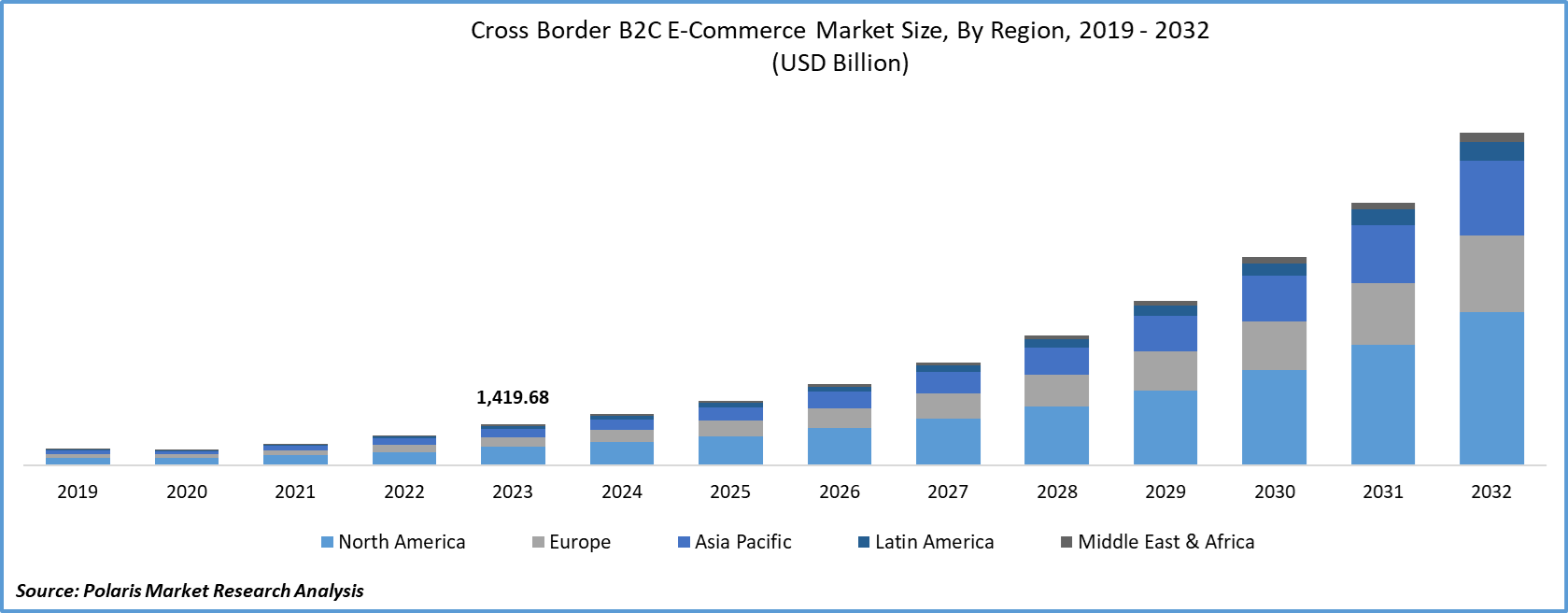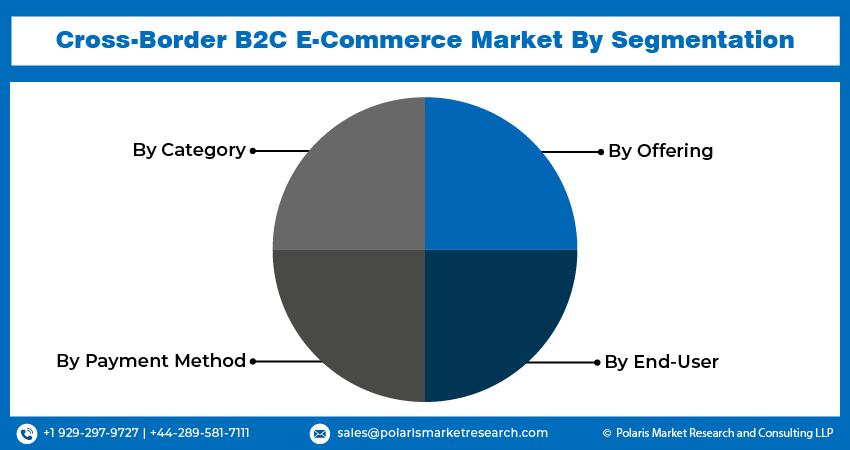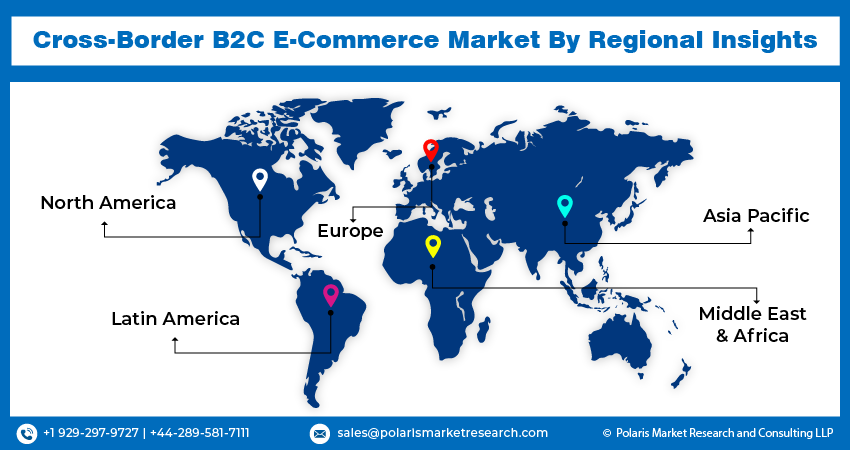
Cross-Border B2C E-Commerce Market Share, Size, Trends, Industry Analysis Report, By Category, By Payment Method (Digital Wallets, Credit/Debit Cards, Internet Banking, Others), By Offering, By End-User (Adults, Teenagers/Millennial, Senior Citizens, Others); By Region; Segment Forecast, 2024 - 2032
- Published Date:Jan-2024
- Pages: 118
- Format: PDF
- Report ID: PM2294
- Base Year: 2023
- Historical Data: 2019-2022
Report Outlook
The global cross-border B2C E-commerce market size was valued at USD 1419.68 billion in 2023. The market is anticipated to grow from USD 1792.77 billion in 2024 to USD 11659.41 billion by 2032, exhibiting the CAGR of 26.4% during the forecast period.
Cross-border B2C E-Commerce is gaining huge momentum because customers buy goods from other countries due to the availability of a wide range of products having better quality at significantly lower prices.

Know more about this report: request for sample pages
Cross-border B2C E-Commerce can be defined as E-Commerce trade across international borders, entailing to purchase and sell products through online stores across international & national borders. This involves a transaction organization that operates in two or more countries. The companies utilize the E-Commerce platform to conduct business and distribute the products using cross-border B2C logistics.
Cross-border B2C E-Commerce is based on internet information technology. Thus, it broadens businesses' growing networks, conducts paperless transactions, and breaks downtime barriers. The increasing international trade among nations coupled with the growing mergers and acquisitions in the industry is anticipated to present lucrative industry growth opportunities. However, logistics-related issues such as import regulations, return logistics, long delivery time, and large shipping costs are expected to hinder the cross-border B2C E-commerce market's growth.
The spread of the COVID-19 reflects the downfall in the industry growth because of the significant disruptions in the supply chain and the temporary halt in transport across nations. The imposed trade barriers and international border closures have resulted in the stoppage of all exports and imports, disrupting the industry development. During the outbreak, various standard carriers could not deliver packages to different regions due to the lack of commercial flights they use for logistics on lockdown restrictions.
However, express carriers maintain their operations as they use their fleet of planes. These disruptions in the supply chain, lockdown measures, and limited consumer and corporate spending are anticipated to hamper industry development. However, the need for Cross-Border B2C E-Commerce is projected to bounce back as governments across nations are lifting lockdown restrictions.

Industry Dynamics
Growth Drivers
The primary factor driving the industry's growth is the increase in the young metropolitan population that relies heavily on technology. The growing internet and smartphone penetration are anticipated to drive the industry's growth. Most millennials use smartphones & tablets to order goods. The industry is further driven by the rising preference for online purchasing due to the increasing influence of social media platforms on shopping habits. Additionally, the unavailability of products in domestic regions is anticipated to boost cross-border B2C E-Commerce.
The availability of higher quality goods at affordable costs is driving the industry's growth. Moreover, cross-border B2C E-Commerce offers considerable benefits to small & medium-sized enterprises to expand their businesses. Moreover, the rising digital adoption index globally is anticipated to provide huge industry growth opportunities. Digital adoption is the measure of the region's digital adoption across various sectors of the economy, including government, people, and business. Businesses are using digital transformation to increase their footprints across different regional industries.
Report Segmentation
The market is primarily segmented on the basis of category, payment method, offering, end-user, and region.
|
By Category |
By Payment Method |
By Offering |
By End-User |
By Region |
|
|
|
|
|
Know more about this report: request for sample pages
Insight by Payment Method
The credit/debit cards segment is recorded to hold the larger shares in 2021 and is expected to lead the cross-border B2C E-commerce market in the forecasting years. The considerable share of the segment can be attributed to the acceptance of payments through credit/debit cards across all E-Commerce platforms. Further, technological advancements such as the use of blockchain for better security are anticipated to boost the segment's growth. The array of exclusive rewards and perks gained by the use of credit cards is estimated to boost the payments made by this method.

The digital wallets segment is projected to show the fastest growth rate in the forecasting years. The launch of cross-border B2C payment platforms is anticipated to drive the segment's growth. For instance, in May 2021, HSBC launched its first global wallet, which is a multi-currency digital wallet for international payments. Furthermore, Citibank Global wallet allows its customers to make an online purchase without incurring foreign currency conversion across 150 countries. Moreover, the growing number of non-bank players is anticipated to offer tremendous cross-border B2C E-commerce market growth opportunities.
Geographic Overview
Geographically, Asia Pacific accounted for the largest revenue share in the global cross-border B2C E-commerce market in 2021. This huge industry share can be attributed to the increasing internet and smartphone penetration across emerging nations. Further, the industry's growth is fuelled by the rapid urbanization, improving living standards, and rising disposable income of the population. The emerging countries such as South Korea, India, Japan, and China are primarily attributing to market growth.
The presence of a large consumer base in the Asia Pacific is anticipated to drive the development of the market. Moreover, the growing trade relations of nations in the region are anticipated to offer tremendous market growth opportunities. For instance, China upgraded its free trade pact with New Zealand, thus expedited processes for exporters, expanded market access, and widened tariff-free schemes.
Moreover, the North America Cross-Border B2C E-Commerce market is anticipated to witness progressive growth over the forecasting years. The fast growth of the market in North America can be attributed to the growing demand for high-quality goods at affordable prices. The region's high PLI (Price Level Index) enables domestic shoppers to do cross-border B2C shopping.

The PLI expresses the price level of a country relative to another. For instance, PLI for the US is 113, while PLI for China is 59. The unavailability of products at cheaper prices domestically is anticipated to drive the market's growth. Further, the region's huge online shopping customer base is expected to offer tremendous market growth opportunities. The US consumers generally prefer to buy from China because of their lower prices.
Competitive Insight
Some of the major players operating in the global cross-border B2C E-commerce market include Alibaba/AliExpress, Amazon, ASOS, eBay, iHerb, Joom, Lazada, Pinduoduo, Shein, shopee, Wish, Zalando, and Zooplus.
Cross-Border B2C E-Commerce Market Report Scope
|
Report Attributes |
Details |
|
Market size value in 2024 |
USD 1792.77 billion |
|
Revenue forecast in 2032 |
USD 11,659.41 billion |
|
CAGR |
26.4% from 2024 - 2032 |
|
Base year |
2023 |
|
Historical data |
2019 - 2022 |
|
Forecast period |
2024 - 2032 |
|
Quantitative units |
Revenue in USD million and CAGR from 2024 to 2032 |
|
Segments covered |
By Category, By Payment Method, By Offering, By End-User, By Region |
|
Regional scope |
North America, Europe, Asia Pacific, Latin America; Middle East & Africa |
|
Key Companies |
Alibaba/AliExpress, Amazon, ASOS, eBay, iHerb, Joom, Lazada, Pinduoduo, Shein, shopee, Wish, Zalando, and Zooplus |
